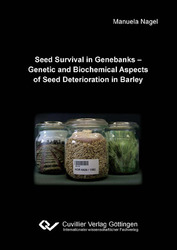| Fachbereiche | |
|---|---|
| Buchreihen (96) |
1378
|
| Nachhaltigkeit |
3
|
| Gesundheitswesen |
1
|
| Geisteswissenschaften |
2364
|
| Naturwissenschaften |
5406
|
| Mathematik | 229 |
| Informatik | 319 |
| Physik | 980 |
| Chemie | 1363 |
| Geowissenschaften | 131 |
| Humanmedizin | 243 |
| Zahn-, Mund- und Kieferheilkunde | 10 |
| Veterinärmedizin | 108 |
| Pharmazie | 147 |
| Biologie | 835 |
| Biochemie, Molekularbiologie, Gentechnologie | 121 |
| Biophysik | 25 |
| Ernährungs- und Haushaltswissenschaften | 45 |
| Land- und Agrarwissenschaften | 1004 |
| Forstwissenschaften | 201 |
| Gartenbauwissenschaft | 20 |
| Umweltforschung, Ökologie und Landespflege | 148 |
| Ingenieurwissenschaften |
1791
|
| Allgemein |
98
|
|
Leitlinien Unfallchirurgie
5. Auflage bestellen |
|
Erweiterte Suche
Seed Survival in Genebanks - Genetic and Biochemical Aspects of Seed Deterioration in Barley
Manuela Nagel (Autor)Vorschau
Inhaltsverzeichnis, Datei (31 KB)
Leseprobe, Datei (260 KB)
Against the background of 7.4 million accessions stored in genebanks, long-term survival of stored seeds is an important trait. This study intended to elucidate genetic and biochemical mechanisms underlying barley (Hordeum vulgare L.) seed deterioration with respect to genetic diversity at different storage treatments ranging from cold storage with low seed moisture content (smc) to experimental seed ageing with high smc.
On the basis of an assumed genetic impact on seed deterioration quantitative genetic analyses using four mapping populations were applied. Seeds of three bi-parental barley mapping populations were experimentally aged. Subsequent quantitative trait locus (QTL) analyses revealed 4 major loci on chromosomes 2H, 5H and 7H explaining a phenotypic variation up to 54%. Detected loci were confirmed by the fourth population that compromises a collection of independent barley accessions. These genotypes, multiplied in two field plots and experimentally aged were analysed by a genome-wide association approach which resulted in 105 marker-trait associations (MTAs) at 32 loci. Putative functions of MTAs and closely linked QTLs revealed predominantly biotic and abiotic stress affect seed longevity.
To address aspects of abiotic, including oxidative stress, the major antioxidant glutathione (GSH) and its half-cell reduction potential (EGSSG/2GSH) were analysed in a set of seeds that had lost viability during genebank storage (5 to 13 years) and a set of artificially aged seeds. A general depletion of the glutathione pool [GSH plus glutathione disulphide (GSSG)] and a shift towards more oxidising conditions occurred with decreasing viability. Highly significant correlations of viability with EGSSG/2GSH but also %GSSG were found. Plotting both parameters against each other, clusters of ageing treatments were formed presumably caused by an acidifying effect of higher smc levels during artificial ageing indicative of different processes occurring when different ageing conditions were used. Tocochromanols were predominately represented as tocotrienols and did not show any relationship with seed deterioration. Viability loss and storage was not correlated with changes in major storage compounds, starch, proteins and oil. In summary, it appears that barley seed ageing was affected by genetic factors, by environmental factors during seed development, by the smc during storage and by the type of ageing treatment.
| ISBN-13 (Printausgabe) | 3869558717 |
| ISBN-13 (Printausgabe) | 9783869558714 |
| ISBN-13 (E-Book) | 9783736938717 |
| Buchendformat | A5 |
| Sprache | Englisch |
| Seitenanzahl | 134 |
| Umschlagkaschierung | matt |
| Auflage | 1 Aufl. |
| Band | 0 |
| Erscheinungsort | Göttingen |
| Promotionsort | Göttingen |
| Erscheinungsdatum | 20.09.2011 |
| Allgemeine Einordnung | Dissertation |
| Fachbereiche |
Land- und Agrarwissenschaften
|








